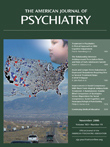Catatonia, a psychomotor syndrome, is defined in DSM classifications mainly as a subtype of schizophrenia. This identification does not recognize the syndrome’s ubiquitous nature, discourages its recognition in other psychiatric illnesses, and limits treatment to protocols that focus on antipsychotic drugs. We suggest that catatonia be reclassified as an individual abnormal behavior, akin to delirium and dementia
(1,
2) .
Catatonia is a syndrome of motor dysregulation characterized by mutism, immobility, negativism, posturing, staring, rigidity, stereotypy, mannerisms, echophenomena, perseveration, and automatic obedience, among others
(1) . Catatonia rating scales describe up to 30 typical signs, assessing degrees of severity and ways to elicit them
(1,
3) . Some features are observed, such as immobility and mutism, but other features must be elicited. A detailed procedure with specific acts and statements by the examiner is described
(1) . To examine for ambitendency, for example, the examiner extends his hand stating “DO NOT shake my hand.” To examine for echopraxia, the examiner scratches his head in an exaggerated manner. The diagnosis of catatonia is made when two or more features are present for more than 24 hours.
The diagnosis may be confirmed by symptomatic improvement after the acute administration of a challenge dose of lorazepam or amobarbital. Confirmation after lorazepam is reported in approximately 80% of patients with catatonia
(1,
4) .
Catatonia is more frequently associated with mania, melancholia, and psychotic depression than it is with schizophrenia. It is also recognized in metabolic diseases, drug intoxications, seizure disorders, and frontal circuitry brain disease
(1,
3,
5) .
Many clinicians believe catatonia to be rare. Yet, it is found in 7% to 15% of psychiatric patients in acute inpatient services and emergency room settings when systematic rules of examination and catatonia rating scales are applied
(1,
3,
5,
6) .
Catatonia appears in many guises. Hypokinetic catatonia (Kahlbaum syndrome), excited catatonia (delirious mania, oneiroid state), malignant catatonia, the neuroleptic malignant and toxic serotonin syndromes, periodic catatonia (rapid cycling mania), and primary akinetic mutism are variations defined by symptoms, course, and responses to a lorazepam challenge
(1,
7) . Catatonia is also a feature in autism
(8) . Each form of the syndrome responds to the treatment protocols for catatonia
(1) .
The optimal treatment is not that of schizophrenia. Indeed, antipsychotic drugs precipitate a malignant syndrome in patients with catatonia
(1,
5) . Sedative anticonvulsant agents, such as barbiturates and benzodiazepines, are the effective agents. The syndrome is remarkably sensitive to ECT
(1,
4,
5) . These treatments are ordinarily not thought to be useful in schizophrenia.
Following the DSM classification model, we designate three catatonia subtypes ( nonmalignant, delirious, and malignant ) and four specifiers (secondary to: mood disorders, general medical conditions or toxic states, neurological disorders, or psychotic disorders ).
Catatonia is an identifiable and treatable motor syndrome in clinical psychiatric patients. It warrants a home of its own in the nomenclature
(2) . Such designation will improve its recognition, optimize its treatment, reduce morbidity and mortality, and offer homogeneous samples for studies of pathophysiology.

